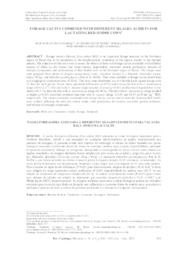Forage cactus combined with different silages as diets for lactating red Sindhi cows.
Forage cactus combined with different silages as diets for lactating red Sindhi cows.
Autoria: SOBRAL, A. J. da S.; MUNIZ, E. N.; SANTOS, R. D. dos; RANGEL, J. H. de A.
Resumo: Forage cactus (Opuntia ficus-indica Mill) is an important forage resource in the Northeast region of Brazil due to its adaptation to the edaphoclimatic conditions of the region, mainly to the drought periods. The objective of this work was to assess the effects of diets with forage cactus combined with different sources of fibers on dry matter and water intakes, digestibility, microbial protein production, balance of nitrogen compounds, and performance of Red Sindhi cows in the Semiarid region of Brazil. The silages used were prepared from plants of Atriplex nummularia Lindi., Sorghum bicolor (L.) Moench, Gliricidia sepium (Jacq.) Walp., and Manihot pseudoglaziovii Pax & K. Hoffm. They were included in forage cactus-based diets at a roughage to concentrate ratio of 58:42. The cows were distributed in a 4×4 double Latin square design with 12 days for each period. Water intake presented differences (p<0.05) when using the diet with A. nummularia silage (19.42 L d-1). The diet with S. bicolor silage resulted in lower (p<0.05) coefficient of digestibility of dry matter (48.71%) than the diet with A. nummularia silage (68.46%). The diet with A. nummularia silage resulted in higher (p<0.05) microbial synthesis than that with G. sepium silage, 115.01 and 80.07 g CPmic kg-1 TDN, respectively. The silages evaluated, combined with forage cactus, can be used as diets for lactating Red Sindhi cows without affecting the daily dry matter intake, milk production, fat content, microbial protein synthesis, and balance of nitrogen compounds.
Ano de publicação: 2022
Tipo de publicação: Artigo de periódico
Unidade: Embrapa Tabuleiros Costeiros
Palavras-chave: Atriplex nummularia, Bovino, Bovino de leite, Bovinocultura, Cactaceae, Forage, Forragem, Opuntia Ficus Indica, Palma Forrageira, Raça Sindi
Observações
1 - Por padrão são exibidas publicações dos últimos 20 anos. Para encontrar publicações mais antigas, configure o filtro ano de publicação, colocando o ano a partir do qual você deseja encontrar publicações. O filtro está na coluna da esquerda na busca acima.
2 - Para ler algumas publicações da Embrapa (apenas as que estão em formato ePub), é necessário ter, no celular ou computador, um desses softwares gratuitos. Sistemas Android: Google Play Livros; IOS: iBooks; Windows e Linux: software Calibre.
Acesse outras publicações
Acesse a Base de Dados da Pesquisa Agropecuária (BDPA) para consultar o acervo completo das bibliotecas da Embrapa.

